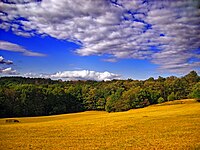
Photo from wikipedia
Fragmented forests generate a variety of forest edges, leading to microclimates in the edge zones that differ from those in the forest interior. Understanding microclimatic variation is an important consideration… Click to show full abstract
Fragmented forests generate a variety of forest edges, leading to microclimates in the edge zones that differ from those in the forest interior. Understanding microclimatic variation is an important consideration for managers because it helps when making decisions about how to restrict the extent of edge effects. Thus, our study attempted to characterize the changing microclimate features at an urban forest edge located on Mt. Gwanak, Seoul, South Korea. We examined edge effects on air temperature, relative humidity, soil temperature, soil moisture, and photosynthetically active radiation (PAR) during the hottest three consecutive days in August 2016. Results showed that each variable responded differently to the edge effects. This urban forest edge had an effect on temporal changes at a diurnal scale in all microclimate variables, except soil moisture. In addition, all variables except relative humidity were significantly influenced by the edge effect up to 15 m inward from the forest boundary. The relative humidity fluctuated the most and showed the deepest extent of the edge effect. Moreover, the edge widths calculated from the relative humidity and air temperature both peaked in the late afternoon (16:00 h). Our findings provide a reference for forest managers in designing urban forest zones and will contribute to the conservation of fragmented forests in urban areas.
Journal Title: Environmental Monitoring and Assessment
Year Published: 2018
Link to full text (if available)
Share on Social Media: Sign Up to like & get
recommendations!